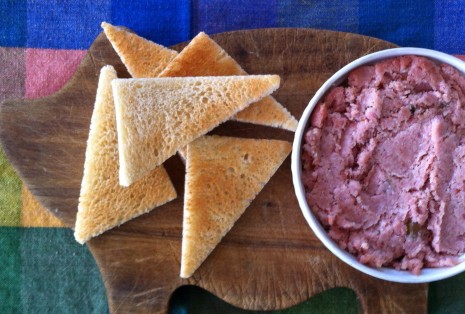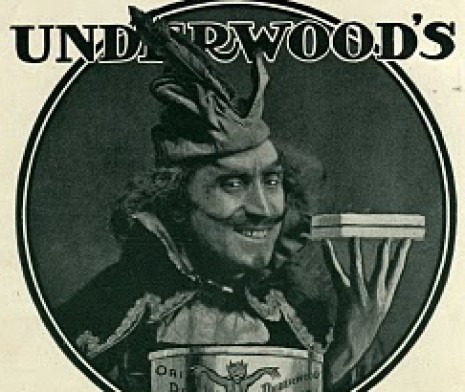DEVILED HAM—THE ULTIMATE PIGGYBACK SNACK
Deviled chicken, deviled eggs, and now … deviled ham. This is not a rut. It’s a trilogy, and my inspiration this week is the Easter ham still commanding pride of place in the refrigerator. From Lobel’s butcher shop (since 1840), it’s a stellar example of a city-cured*, or baked, ham. There is enough tender, juicy, rosy-pink meat left over for thick-cut sandwiches with chutney, and for larding a mac and cheese, scalloped potatoes, or gumbo later in the week. But what I am really, really looking forward to is deviled ham. With toast points.
In the United States, usage of the culinary term deviled to mean highly seasoned with spices or condiments dates from the early 19th century or well before, according to Janet Clarkson’s entertaining blog, The Old Foodie. The type of deviling that I’m most familiar with, however, isn’t especially fiery or peppery; instead, it gets a decided nip from Dijon mustard, usually with an assist from a little cayenne. Damon Lee Fowler, in his masterful Classical Southern Cooking, will back me up here.
Deviled ham rightly belongs to the far larger category of potted meats. Two centuries ago, I would have had to pound the cooked ham (or partridge, ox tongue, hare, etc.) to a smooth paste with butter in a large stone or marble mortar, then season it with salt, pepper, and perhaps mace and cayenne. Pressed into small crocks and sealed with clarified butter, my potted ham would have kept about two weeks in a cool, dry place.
I’m not much for historical re-enactments, so the food processor and refrigerator are more my speed, especially after a pep talk from culinary historian Rick Ellis. “Make canapés!” he said, and was off and running. “They were one of the first hors d’oeuvres served with drinks. I’ll bet there is a recipe in Fannie Farmer.” That’s Rick for you. His mind leaps to an icon in American culinary history, and mine leaps to—well, another icon, Jack Benny, who once famously defined an hors d’oeuvre as a ham sandwich cut into 40 pieces.
I could have spent the next hour entranced by YouTube clips of the Jack Benny Show. Rick, however, was paging gently though his 1918 edition of Fannie Farmer’s Boston Cooking-School Cook Book, which took pains with the description of the newfangled concept of canapés:
Canapés are made by cutting bread in slices one-fourth inch thick, and cutting the slices in strips … or in circular pieces. The bread is toasted, fried in deep fat, or buttered and browned in the oven, and covered with a seasoned mixture of eggs, cheese, fish, or meat, separately or in combination. Canapés are served hot or cold, and used in place of oysters at a dinner or luncheon. At a gentlemen’s dinner party they are served with a glass of Sherry before entering the dining room.
I’m sure they’ve always known that at the Augusta National Golf Club.
As for the deviled ham, Rick explained that the original [privately printed] 1931 edition of The Joy of Cooking has a recipe for Ham Sandwich Spread. “It was seasoned with mustard, salt, pepper, and vinegar,” Rick said. After a brief rummage in his library, he continued, “In the seventy-fifth anniversary edition, there’s a recipe specifically for Deviled Ham, made with ham and butter or mayonnaise. I’m sure it appeared earlier, though, I just don’t know which edition.”
Although Marion Cunningham’s reborn classic, The Fannie Farmer Cookbook (1979) has a recipe for Deviled Ham Spread, too, I would guess it’s an artifact from the 1950s: the first ingredient is two 4½-ounce cans of deviled ham. Don’t get me wrong. I grew up on Mr. Underwood’s deviled ham spread—along with Vienna sausages, it was standard fare at our house for riding out hurricanes—but I think somewhere along the line, the company changed the formula. It can’t possibly have been as salty or as scarily airy in texture as it is now. The oldest trademark in the United States** deserves a better product.
So instead I used Marion Cunningham’s plain Ham Spread as a starting point for the recipe below. It is simple and good, and will tide me over until I get around to making gumbo. Or deep-fried toast points.
Deviled Ham with Toast Points
Makes 2 cups
About 8 slices of best-quality white sandwich bread
2 cups (about ½ pound) chopped cooked city-cured (baked) ham
1 tablespoon minced onion
2 to 3 teaspoons Dijon mustard
A small pinch cayenne pepper
An even smaller pinch ground mace (optional)
1 tablespoon minced sweet pickle
2 tablespoons mayonnaise or well softened (but not oozy) unsalted butter
Salt and freshly ground pepper to taste
1. Heat oven to Broil and set rack about 6 inches from heat. Put the bread slices on a baking sheet and broil until pale golden and crisp on top, about 1 minute or so. Flip the slices and broil until pale golden on other side, about 1 minute. While bread is still hot, trim crusts and cut into triangles or strips. Once cool, the toast points will keep in an airtight container up to 1 day.
2. Purée the ham in a food processor. Scrape it into a bowl, then stir in the rest of the ingredients. Pack the deviled ham into a small crock and chill. Theoretically, this should keep at least a week or so, but good luck keeping it around that long.
* As opposed to a country, or dry-salt-cured ham, which is best enjoyed sliced paper-thin and tucked into biscuits. I’m a longtime fan of Allan Benton‘s country hams.
** Thank you, Rick, for cluing me in to the irresistible website papergreat.com.
Posted: April 10th, 2012 under cookbooks, culinary history, recipes, spring.
Comments
Comment from admin
Time April 11, 2012 at 7:50 am
I remember Reeve’s! And that strawberry pie….
Comment from Jean Dabbs
Time April 10, 2012 at 5:50 pm
I have not thought about deviled ham in years…..thanks for the memories..
Comment from Mary James
Time April 10, 2012 at 11:57 pm
Bonjour Jane….when I saw deviled ham, I immediately thought of the 1950’s 60’s and hurricanes. My parents would throw a can or two of Underwood’s and some Vienna sausages into the Scotch cooler….along with a bottle of Scotch for them and we were off to a motel to ride out the storm. Then you mentioned the same thing…..Crazy!!




Comment from Jane Grenier
Time April 10, 2012 at 12:10 pm
J’adore ham salad!! Fond memories of going downtown with my father in Washington DC to Reeve’s (sadly, closed since ’07) and enjoying their ham salad sandwich and strawberry pie…